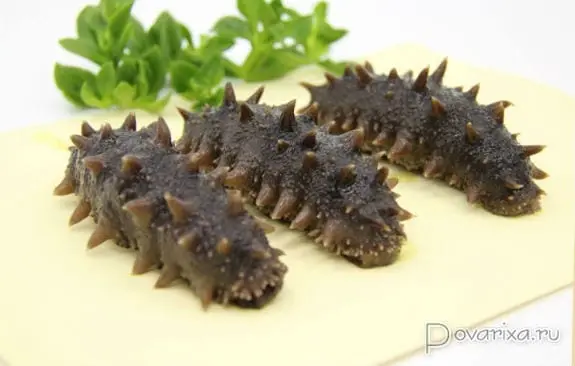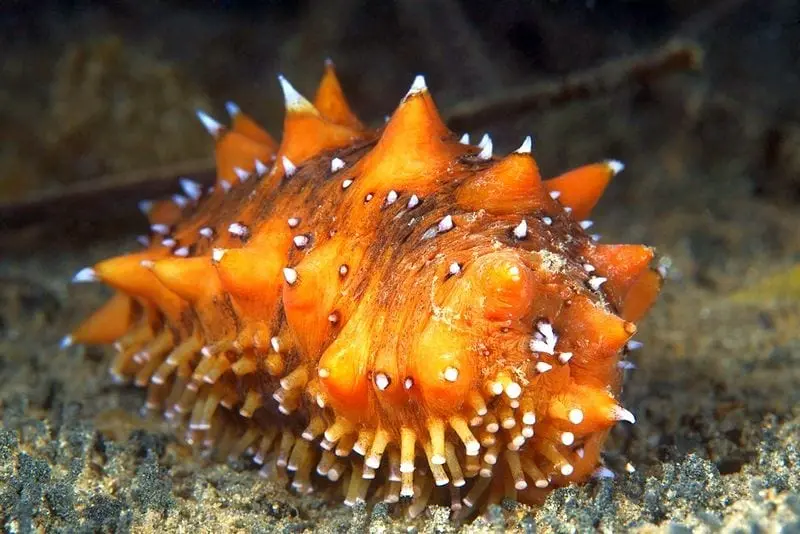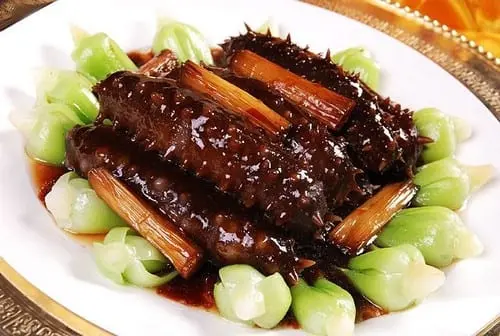Contents
Description
Among the different breeds of sea cucumbers there is a very valuable commercial breed – trepang. Trepangs are those types of sea cucumbers that can be eaten. Trepang has long been valued as a food and medicine in traditional oriental medicine.
Trepangs are peaceful and harmless creatures, they live in the salty seas of the Far East at a shallow depth, close to the coast, hiding in thickets of algae and in crevices of rocks. Trepang cannot live in fresh water, it is deadly for him. Even slightly salted seas are not suitable for him.
The Far Eastern trepang is the most valuable species, both for science and for health.
In Eastern medicine, trepang has long been used as an effective remedy against many serious ailments and, due to its therapeutic effect, it aimed along with ginseng. The healing properties of sea cucumbers are reflected in its Chinese name “Heishen” – “sea root” or “sea ginseng”.

Mentions about the miraculous properties of trepang are found in treatises of the 16th century. The ancient imperial dynasties of China used trepang infusion as a rejuvenating elixir that prolongs life. Studies have confirmed that the trepang tissues are ideally saturated with trace elements and biologically active substances, which explains the rejuvenating effect.
In terms of the composition of mineral substances, no other known organism can compare with trepang.
Trepang meat contains proteins, fats, vitamins B12, thiamine, riboflavin, mineral elements, phosphorus, magnesium, calcium, iodine, iron, copper, manganese. Trepang fat is rich in unsaturated fatty acids, phosphatides.
The product of sea cucumber on honey “Sea honey” is made from selected cucumber, suitable for microbiological and chemical parameters, crushed and mixed raw with honey.
The biologically active additive is used for baking bread and other culinary products.
Composition and calorie content

Thick walls of sea cucumber are used for food. Its soft, lean meat is rich in vitamins and minerals. Trepangs are eaten raw, salted and dried. Trepang meat has long been included in the diet of peoples living in the Primorsky and Khabarovsk territories.
So, the Udege (“forest people”, they call themselves – Ude, Udehe) traditionally harvested seaweed and trepangs on the seashore. The main food products of the Udege have always been meat and fish. Despite the fact that the modern diet of the Udege people has been replenished with bread, confectionery, cereals, vegetables and fruits, trepangi and wafa (red fish caviar) remain the favorite dishes of the Udege. Udege people prepare many dishes from trepang, fried, boiled, salted and dried.
Trepang meat contains 4-10% protein, about 0.7% fat, calorie content – 34.6 Kcal. More than 50 elements necessary for the human body have been found in the trepang meat.
Trepang meat contains a thousand times more copper and iron compounds than fish, and a hundred times more iodine than other seafood.
- Calories 56
- Fat 0,4 g
- Carbohydrates 0 g
- Protein 13 g
The benefits of trepang
Trepang, popularly called sea cucumber, or ginseng, is a mysterious creature belonging to the Echinoderm type. In Chinese and Japanese cuisine, he, like many other exotic and strange aquatic inhabitants, is highly respected. These creatures prefer to live in shallow waters in the southern seas.
The healing properties of trepang
For the first time, the medicinal properties of sea cucumbers are described in the 16th century in the Chinese book “Wu Tsza-Tszu” Trepangs have been used as food and medicine since time immemorial. The sea cucumber has no enemies, as its tissues are oversaturated with microelements that are toxic to marine predators and the most valuable for medicinal purposes.
Unique substances increase the body’s resistance to infections, help with intoxication, normalize blood pressure, improve the functioning of the cardiovascular system, lower blood sugar in diabetes, normalize the functioning of the gastrointestinal tract and genitourinary system, and also have antiherpes properties.

For medicinal purposes, trepang is also used to activate the immune system, for diseases of the musculoskeletal system, prostate adenoma, periodontal disease, and diseases of the ENT organs.
In traditional Chinese medicine, trepang meat and medicinal products made from it are advised to be taken at a time of day when certain organs are most active. So, from one to three in the morning, the best time to treat the liver, gallbladder, vision, spleen, joints.
From three to five in the morning – the time of the large intestine, nose, skin and hair. From five to seven in the morning – it is advised to treat diseases of the small intestine. From eight to nine in the morning, the bone marrow and stomach are activated. From nine to eleven in the morning, the pancreas and thyroid glands are activated.
From eleven in the morning to one in the afternoon, trepang is advised to be taken to normalize the work of the heart, blood vessels, psyche and sleep, and sexual functions. From three to five in the evening, the bladder and gynecological organs, as well as bones and blood, are active.
From five to seven in the evening, it is the turn of the kidneys, then from seven to eight in the evening all vessels are active. From 9 pm it is time for the normalization of sexual functions.
How to cook trepang
The culinary processing of trepang meat is varied; they can be boiled, stewed, fried and marinated. Trepang broth is used for making soups, borscht, pickles. Trepang meat gives soups a flavor that is reminiscent of canned fish.
Almost all dishes, stewed, fried, marinated, and even soups, are prepared from pre-cooked trepangs. For use for medicinal purposes, it is best to stew trepangs; with this method of preparation, useful substances pass into the broth, and it acquires medicinal properties.

Ice cream trepang must first be defrosted on the top shelf of the refrigerator, then it is prepared in the same way as fresh – cut lengthwise and thoroughly washed. It is necessary to rinse the meat of the dried sea cucumber until the water becomes clear in order to wash off the charcoal powder, which is used for drying. After washing, the trepangs are soaked in cold water for 24 hours, changing the water three to four times.
For cooking trepangs are thrown into salted boiling water. After about three minutes of cooking, the broth turns black due to the very high iodine content of the trepang, after which it must be drained. This is repeated several times until the broth stops turning black. The main thing is not to digest trepang for more than three minutes, so as not to spoil the taste and texture of the meat.
What a trepang tastes like
The taste is peculiar and spicy, similar to the taste of raw squid or scallops, it is pure protein. Hearty meat that you need to know how to cook properly.
A scraper is made from trepang, this is the most popular dish. Pickles and hodgepodge are prepared. It is marinated and cooked raw and is called heh.









